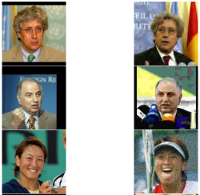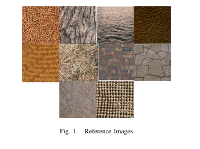
SynTEX Granularity Database
In this dataset we show the effect of texture granularity, on the quality of synthesized textures. For this purpose, subjective studies are conducted to assess the quality of synthesized textures with different levels (low, medium, high) of perceived texture granularity using different types of texture synthesis methods.

Quality Labeled Faces in the Wild (QLFW)
The varying quality of face images is an important challenge that limits the effectiveness of face recognition technology when applied in real-world applications. Existing face image databases do not consider the effect of distortions that commonly occur in real-world environments. This database (QLFW) represents an initial attempt to provide a set of labeled face images spanning the wide range of quality, from no perceived impairment to strong perceived impairment for face detection and face recognition applications. Types of impairment include JPEG2000 compression, JPEG compression, additive white noise, Gaussian blur and contrast change. Subjective experiments are conducted to assess the perceived visual quality of faces under different levels and types of distortions and also to assess the human recognition performance under the considered distortions. One goal of this work is to enable automated performance evaluation of face recognition technologies in the presence of different types and levels of visual distortions. This will consequently enable the development of face recognition systems that can operate reliably on real-world visual content in the presence of real-world visual distortions. Another goal is to enable the development and assessment of visual quality metrics for face images and for face detection and recognition applications.

QualTex
Textures are being extensively used in next-generation video coding, image restoration and computer graphics wherein the stochastic and perceptual properties of textures are exploited. Given the prominence of texture content in image and video processing applications, texture quality assessment and objective quality metrics geared specifically towards texture are of particular importance. This paper outlines an extensive subjective study in which a total of 340 distorted images extracted from 10 reference images were evaluated by a group of 20 human subjects. The subjective Mean Opinion Scores (MOS) thus obtained from the study were used to evaluate several existing mainstream full reference quality metrics with the help of a recently developed quality assessment framework (IVQUEST). Based on the results obtained, it can be concluded that traditional objective metrics do not perform well on texture images and there is a need for specialized texture quality metrics.
Texture Granularity Database (GranTEX)
The GranTEX database has 30 images of textures with different granularity levels. The granularity of the selected textures in the database can be classified into three levels — low, medium and high. These textures along with their subjective granularity scores are available as a part of this database.
JPEG2000 Compressed GranTEX Database (J2KGranTEX)
This database consists of 15 textures from the GranTEX database which are compressed at 8 different levels using JPEG2000 compression standard. The database also includes mean opinion scores (MOS) obtained from the subjective study.
Texture Regularity Database (RegTEX)
This is a texture regularity database consisting of 21 textures exhibiting varying degrees of perceptual regularity and the their corresponding subjective regularity scores. An additional 5 sets of textures were generated from the original 21 textures through geometric and photometric transformations. These textures along with their subjective regularity scores are also available as a part of this database.
Synthesized Texture Quality Database – SynTEX
In this texture database (SynTEX), we evaluate the effect of texture regularity and granularity on the perceived quality of synthesized textures. The textures were synthesized using various paramteric and non-parametric texture synthesis algorithms.